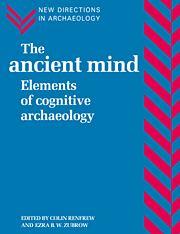Book contents
- Frontmatter
- Contents
- List of figures
- List of tables
- List of contributors
- Preface
- PART I INTRODUCTION
- PART II THE INTERDISCIPLINARY UNDERPINNING
- PART III APPROACHES TO CULT PRACTICE AND TRANSCENDENTAL BELIEF SYSTEMS
- PART IV PREHISTORIC CONCEPTIONS OF SPACE AND TIME
- 10 Symbols and signposts - understanding the prehistoric petroglyphs of the British Isles
- 11 Knowledge representation and archaeology: a cognitive example using GIS
- 12 Dials: a study in the physical representation of cognitive systems
- PART V THE MATERIAL BASIS OF COGNITIVE INFERENCE: TECHNOLOGY
- PART VI THE MATERIAL BASIS OF COGNITIVE INFERENCE: WRITING SYSTEMS
- PART VII CONCLUSION
- Index
10 - Symbols and signposts - understanding the prehistoric petroglyphs of the British Isles
Published online by Cambridge University Press: 03 December 2009
- Frontmatter
- Contents
- List of figures
- List of tables
- List of contributors
- Preface
- PART I INTRODUCTION
- PART II THE INTERDISCIPLINARY UNDERPINNING
- PART III APPROACHES TO CULT PRACTICE AND TRANSCENDENTAL BELIEF SYSTEMS
- PART IV PREHISTORIC CONCEPTIONS OF SPACE AND TIME
- 10 Symbols and signposts - understanding the prehistoric petroglyphs of the British Isles
- 11 Knowledge representation and archaeology: a cognitive example using GIS
- 12 Dials: a study in the physical representation of cognitive systems
- PART V THE MATERIAL BASIS OF COGNITIVE INFERENCE: TECHNOLOGY
- PART VI THE MATERIAL BASIS OF COGNITIVE INFERENCE: WRITING SYSTEMS
- PART VII CONCLUSION
- Index
Summary
‘… Even the noticing beasts are aware that we don't feel very securely at home in this interpreted world.’
Rainer Maria Rilke, First Duino Elegy (trans. J. B. Leishman)Introduction
How did people perceive the landscapes in which they lived? That is an important question for a cognitive archaeology, but one which our source materials may seem poorly equipped to answer. The geographer considers the human experience of place through written sources: the ‘geographies of the mind’ collected by Lowenthal and Bowden consider the ‘habits of thought that condition what people learn about environment and environmental processes’, but the papers published under that title rely on ‘traces of human attitudes left in the form of diaries, letters, textbooks, scholarly articles, novels, poems and prayers’ (Lowenthal and Bowden 1976: 6; cf. Tuan 1977, Buttimer and Seamon 1980, Cox and Golledge 1981).
Prehistorians confront additional problems. Their most developed techniques for studying the ancient landscape form only part of an approach whose main concern is with human adaptation to resources. There is much to be learned from studies of food production, but they shed no light on the problems of cognition (Barker and Gamble 1985). The same is true of ‘landscape archaeology’. Detailed topographical survey can sometimes show how the landscape was organised, but although it may be possible to recognize changes in its development over time, it is rare for these to be studied alongside the broader changes in perception and practice that they must have entailed.
- Type
- Chapter
- Information
- The Ancient MindElements of Cognitive Archaeology, pp. 95 - 106Publisher: Cambridge University PressPrint publication year: 1994
- 8
- Cited by

